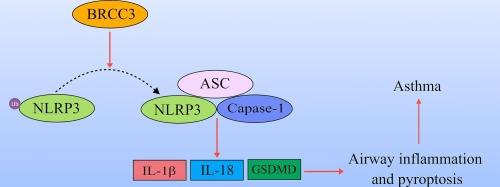BRCC3的缺失通过抑制NLRP3炎性体的激活来改善哮喘患者的气道炎症。
IF 4.7
2区 医学
Q2 IMMUNOLOGY
引用次数: 0
摘要
BRCA1/BRCA2-containing complex亚基3 (BRCC3)作为一种去泛素化酶参与多种炎症相关疾病。然而,BRCC3在哮喘气道炎症调节中的作用尚未被研究。本研究旨在通过卵清蛋白(OVA)诱导的哮喘小鼠模型研究BRCC3在气道炎症中的作用。在哮喘小鼠中发现BRCC3水平升高。与野生型(WT)小鼠相比,BRCC3基因敲除(KO)小鼠的病理变化明显改善,炎症细胞浸润和炎症细胞因子水平降低。在哮喘小鼠中,NLRP3炎症小体高度活化,BRCC3 KO抑制了这种活性,同时NLRP3、ASC、cleaved Caspase-1、cleaved Gasdermin D (GSDMD)、IL-1β和IL-18的表达减少。体外研究表明,BRCC3水平在室内尘螨(HDM)刺激下,气道上皮细胞中的BRCC3水平升高,这取决于暴露的剂量和持续时间。沉默气道上皮细胞中的BRCC3可保护hdm诱导的细胞损伤和炎症,同时抑制NLRP3炎症小体和焦亡。相反,BRCC3在气道上皮细胞中的过表达加重了dm诱导的细胞损伤和炎症,同时也增强了NLRP3炎症小体和焦亡。进一步的研究表明,沉默BRCC3增加了NLRP3的泛素化,而过表达BRCC3则降低了它的泛素化。药物抑制NLRP3炎性小体可降低BRCC3过表达对HDM诱导的气道上皮细胞炎症和焦亡的影响。总之,这些发现强调了BRCC3在哮喘发病机制中的重要性。BRCC3的缺失通过阻碍NLRP3炎性体的激活来减轻哮喘气道炎症,从而表明BRCC3可以作为哮喘治疗的潜在靶点。本文章由计算机程序翻译,如有差异,请以英文原文为准。

Deletion of BRCC3 ameliorates airway inflammation in asthma by inhibiting the activation of NLRP3 inflammasome
BRCA1/BRCA2-containing complex subunit 3 (BRCC3) serves as a deubiquitinating enzyme contributing to multiple inflammation-related disorders. However, the role of BRCC3 in modulating airway inflammation in asthma has not been investigated. This study aimed to examine the role of BRCC3 in airway inflammation using a mouse model of asthma induced by ovalbumin (OVA). BRCC3 levels were found to be elevated in mice with asthma. BRCC3 knockout (KO) mice demonstrated a notable improvement in pathological changes, accompanied by reduced levels of inflammatory cell infiltration and inflammatory cytokines, compared to wild-type (WT) mice following OVA challenge. The NLRP3 inflammasome was high activated in asthmatic mice, which was restrained by BRCC3 KO, as companied by a decrease in NLRP3, ASC, cleaved Caspase-1, cleaved Gasdermin D (GSDMD), IL-1β, and IL-18. In vitro studies demonstrated BRCC3 levels increased in airway epithelial cells in response to house dust mite (HDM) stimulation, depending on the dose and duration of exposure. Silencing BRCC3 in airway epithelial cells protected against HDM-induced cell injury and inflammation, along with inhibiting the NLRP3 inflammasome and pyroptosis. Conversely, the overexpression of BRCC3 in airway epithelial cells worsened DM-induced cell injury and inflammation while also enhancing the NLRP3 inflammasome and pyroptosis. Further investigations revealed that silencing BRCC3 increased the ubiquitination of NLRP3, whereas overexpressing BRCC3 decreased it. Pharmacological inhibition of the NLRP3 inflammasome diminished the effects of BRCC3 overexpression on the inflammation and pyroptosis induced by HDM in airway epithelial cells. Overall, these findings underscore the importance of BRCC3 in the pathogenesis of asthma. Deletion of BRCC3 alleviates airway inflammation in asthma by impeding the activation of the NLRP3 inflammasome, thus indicating that BRCC3 could serve as a potential target for asthma therapy.
求助全文
通过发布文献求助,成功后即可免费获取论文全文。
去求助
来源期刊
CiteScore
8.40
自引率
3.60%
发文量
935
审稿时长
53 days
期刊介绍:
International Immunopharmacology is the primary vehicle for the publication of original research papers pertinent to the overlapping areas of immunology, pharmacology, cytokine biology, immunotherapy, immunopathology and immunotoxicology. Review articles that encompass these subjects are also welcome.
The subject material appropriate for submission includes:
• Clinical studies employing immunotherapy of any type including the use of: bacterial and chemical agents; thymic hormones, interferon, lymphokines, etc., in transplantation and diseases such as cancer, immunodeficiency, chronic infection and allergic, inflammatory or autoimmune disorders.
• Studies on the mechanisms of action of these agents for specific parameters of immune competence as well as the overall clinical state.
• Pre-clinical animal studies and in vitro studies on mechanisms of action with immunopotentiators, immunomodulators, immunoadjuvants and other pharmacological agents active on cells participating in immune or allergic responses.
• Pharmacological compounds, microbial products and toxicological agents that affect the lymphoid system, and their mechanisms of action.
• Agents that activate genes or modify transcription and translation within the immune response.
• Substances activated, generated, or released through immunologic or related pathways that are pharmacologically active.
• Production, function and regulation of cytokines and their receptors.
• Classical pharmacological studies on the effects of chemokines and bioactive factors released during immunological reactions.

 求助内容:
求助内容: 应助结果提醒方式:
应助结果提醒方式:


